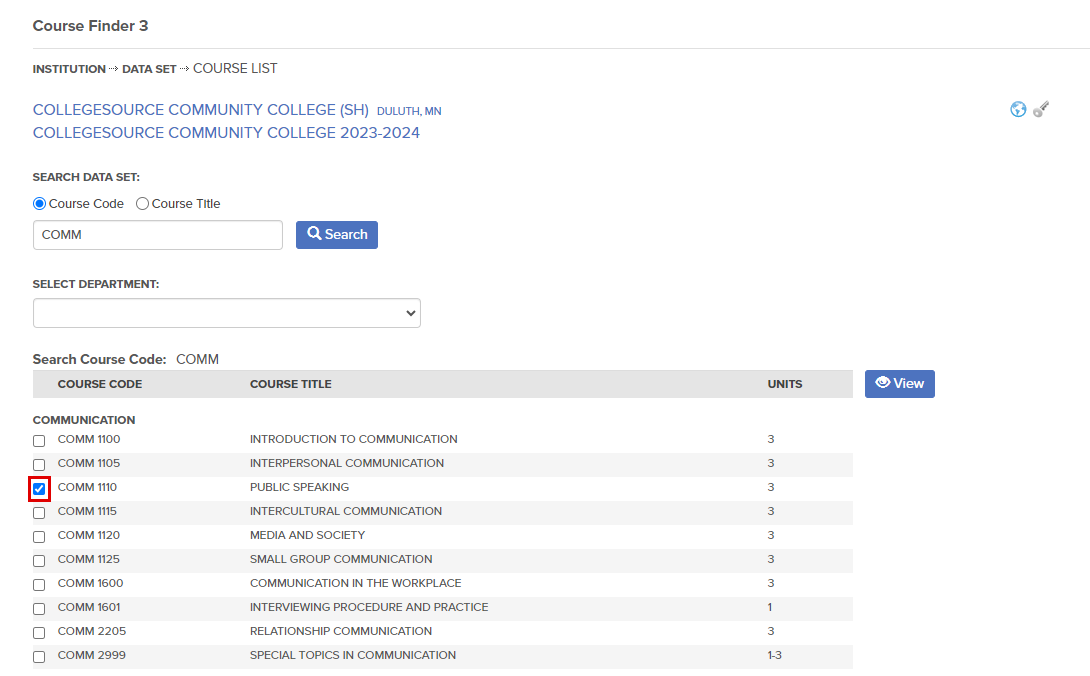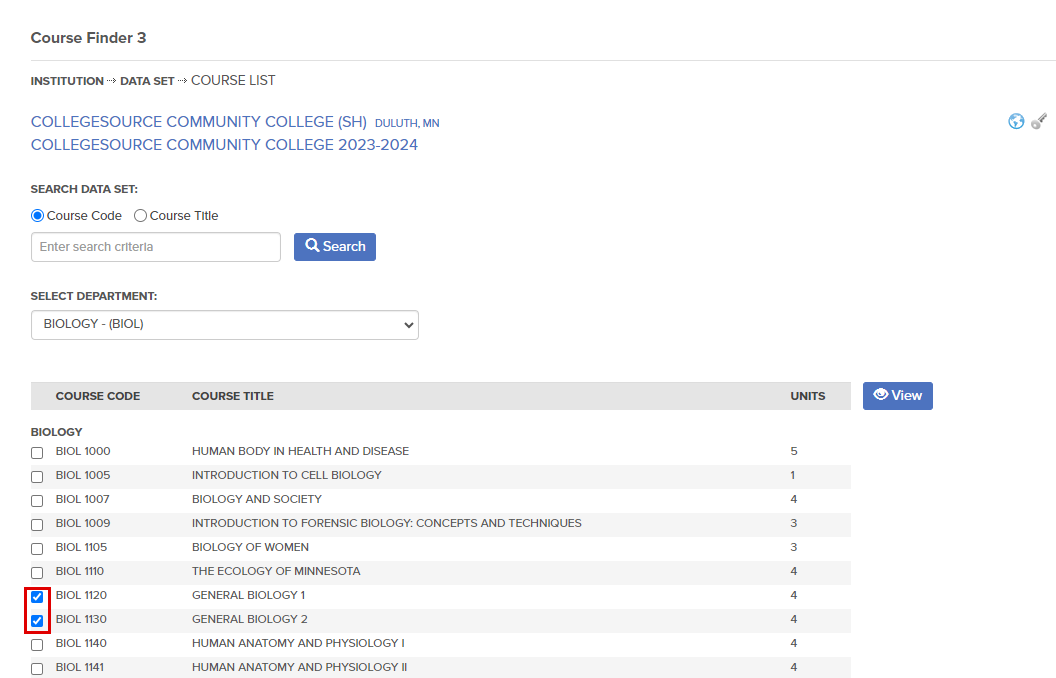Create Evaluation Tasks with Proposed Equivalencies
This article contains instructions for creating evaluation tasks with proposed equivalencies. Individuals with the CREATE EVAL user right can use this functionality to speed up the evaluation process by providing the evaluator with a suggested equivalent course(s), potentially reducing the number of steps required to complete the review.
In this article:
When creating an evaluation task, the transfer course(s) can be sent with or without a proposed equivalency (or equivalencies). A proposed equivalency may result in an expedited review and help bolster faculty collaboration and support.
To create an evaluation task with a suggested equivalency:
- Go to the Search menu.
- Select Course Finder.
Locate the Institution
See Create Evaluation Tasks with User Added Courses if reviewing courses from user-created institutions.
- Within the INSTITUTION SEARCH, enter the name of the institution.
- The U.S. Schools radio button is selected by default.
- To search for institutions outside of the United States, toggle either the Non U.S. Schools or All radio button.
- The U.S. Schools radio button is selected by default.
- Select the Search button.
- Select the arrow to the left of the institution's name ("Select an institution").
Select a Data Set
- Under DATA SET, select the data set containing the course that needs evaluation.
- Another option is to use the Course Code or Course Title radio buttons to search across all data sets.
- Click on or tab to the Select button.
If the data set needed is not available, see Catalog Status Tracking: Check the Status of and Request a School's Catalog for further instructions.
- Select the checkbox to the left of the course or course(s) for which an evaluation task(s) will be created.
- A user may create one evaluation task containing one or many courses. Additionally, individual evaluation tasks can be generated for multiple courses using Batch Eval Mode and Sequence Eval Mode (see below).
- Search by Course Code, Course Title, or use the SELECT DEPARTMENT drop-down to see all courses within a Department.


- Select View.
View Equivalency and Evaluation Histories
Once the course(s) has been selected, the user will be taken to Course Finder 4, where the following can be viewed:
- The course description(s).
- Equivalencies previously created to the course(s).
- Reviews of the course(s) conducted through the Evaluation Tracker Workflow.
A course(s) may have:
- No equivalency or evaluation history.
- In this case, it will be indicated that no data records were found.
- An equivalency history but no evaluation history.
- This means that an equivalency was created to the transfer course, but the course was not reviewed through the Evaluation Tracker workflow.
- An evaluation history but no equivalency history.
- This means that the course was reviewed through the Evaluation Tracker workflow, but no equivalency was created.
- Multiple equivalency and evaluation histories.
View Equivalency History
To view a course or course's equivalency history, select the arrow ("View course equivalency detail") to the left of the course code(s) within the TRANSFER COURSE(S) field.
At the top, the user will see up to four fields, depending on user rights.
BEGIN DATE First day on which the equivalency is effective Format: (MM/DD/YYYY) If no Begin Date is entered, the equivalency is considered effective from the “beginning of time” (or at least since the course was created) |
END DATE Last day on which the equivalency is effective Format: (MM/DD/YYYY) If no End Date is entered, the equivalency is considered effective into the future |
PUBLIC NOTE Note to display in the Public View |
PRIVATE NOTE Note documenting the evaluation process or the rationale behind the evaluation Only visible to users with the ACCESS EQ or CREATE EQ user right (or TES Administrators) |
The transfer course(s) will appear to the left of the page and the equivalent home course(s) to the right.
View Evaluation History
To view a course or course's evaluation history, select the arrow ("View evaluation detail") to the left of the course code(s) within the TRANSFER COURSE(S) field.

At the top, the user will see the following fields:
| Field |
ASSIGNED TO Person to whom the evaluation task is currently assigned or was last assigned |
CREATE DATE Date and time the evaluation task was created (time is reported in Pacific time) |
CREATED BY Name and job title of the person who initiated the evaluation task |
COMMENTS Notes or additional information supplied by the evaluation task creator |
The user will additionally see the evaluation details, such as a proposed or selected equivalency, and the EVALUATION LOG details.
View Peer Equivalencies
If the school's TES Administrator has turned on Peer Sharing, users can additionally view public equivalencies to the selected course(s) from schools the user's Administrator has identified as peer institutions. See Peer Sharing: View Peer Equivalencies for further information.
Select a Proposed Equivalency
There are multiple ways to select a proposed equivalency (or equivalencies) in TES®.
EQ Search
The EQ Search takes keywords from a transfer course title and compares them to the home institution's titles and descriptions to find possible equivalencies. The ACCESS EQ user right is required to use this functionality. If this right is not granted, the button will not appear to the user on Course Finder 4. Follow this link for further instructions.

Select from Data Sets
If not using the EQ Search, a proposed equivalency can be selected through the footprint icon ("Create evaluation for all courses below").

Once selected:
- Select the appropriate data set from the home institution using the drop-down.
- Select the department in which the proposed equivalency resides using the drop-down.
- Select the + sign ("Add course") button to the left of the course to be evaluated..
To view the course description of either the transfer or home course, hover over the COURSE CODE field and select the hyperlink.
The proposed equivalency will appear across from the transfer course(s) under EQUIVALENT COURSE(S).
Users may add additional proposed equivalencies as needed. Single Eval Mode is selected by default, so a single evaluation task would be created for the course or courses selected. This means that if two or more courses are selected from the transfer institution, one evaluation task will be created that will contain all these courses.
Users can also create batches or sequences of evaluation tasks. Further documentation is available to guide users through their creation. After review, return to this section of the documentation to route the evaluation task.
Route the Evaluation Task
To route the evaluation task to an evaluator:
- From Add Evaluation Task 1, select Preview.
- Use the Assign drop-down to choose the evaluator to receive the review.
- A list of all users with the SERVICE EVAL right will be displayed. The user's job title, if entered in User Management, will appear in parentheses.
- If the evaluator should receive an e-mail alert, make sure that the Send email alert? checkbox is enabled.
- TES Administrators can enable this by default within the Evaluation Tracker. It is recommended practice to send an evaluation task e-mail alert so the recipient is aware a task is awaiting completion.
- Add optional comments to the evaluator in the Comments field.
- Select Choose File to upload a PDF(s) related to the evaluation.
- When assigning an evaluation task, users can upload up to two PDFs of the course content to help facilitate its review.
- Each file must be less than 10 MB in size and cannot exceed the combined 20MB limit.
- Select the second Choose File box to upload a second PDF.
- When assigning an evaluation task, users can upload up to two PDFs of the course content to help facilitate its review.
Support files can only be attached to evaluations sent through Single Eval Mode.
Support files can be attached after initiating an evaluation task via the My Evaluations and All Open Evaluations queues. Users can upload as many PDFs as needed, two at a time, up to the abovementioned size limits.
The SERVICE EVAL user right is required to access My Evaluations; the SERVICE EVAL and MANAGE EVAL USER rights are required to access All Open Evaluations.
- Select Create Evaluation Task.
Next Steps
Once the evaluation task has been sent to the evaluator, the user will have up to five navigation buttons to choose from, depending on user rights.
- Select New Course to choose a different course from the same institution, data set, and Department.
- Select New Institution to choose a course from a different institution.
- Select My Queue to navigate to the user's My Evaluations queue (My Evaluations - Assigned to me).
- The SERVICE EVAL user right is required.
- Select New Evaluation to create a new evaluation task for a course from the same institution, data set, and Department to the same data set and Department from your institution.
- The user can change either or both data sets or Departments if desired,
- Select New Equivalency to create an equivalency to a course from the same institution, data set, and Department to the same data set and Department from the home institution in the Equivalency Manager.
- The CREATE EQ user right is required.
- The user can change either or both data sets or Departments if desired.










